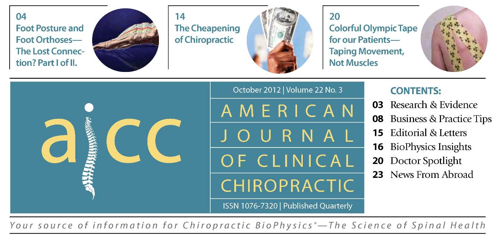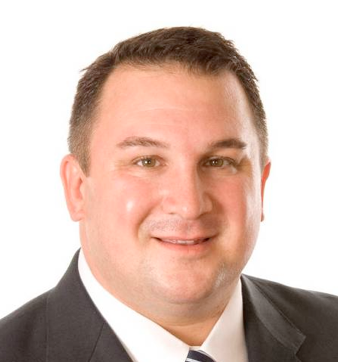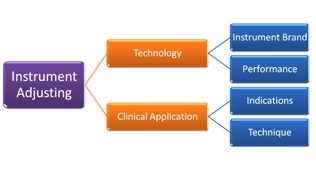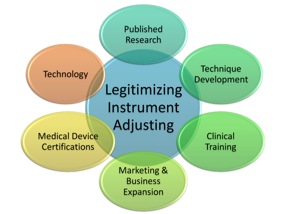Special Issue on Spinal Manipulation to Appear in the Journal of Electromyography and Kinesiology
 Monday, December 17, 2012 at 9:02AM
Monday, December 17, 2012 at 9:02AM  Christopher J. Colloca, D.C.
Christopher J. Colloca, D.C.
CEO and Founder of Neuromechanical Innovations
At the invitation of Moshe Solomonow, PhD, MD (Hon), Editor of The Journal of Electromyography and Kinesiology, three prominent individuals in the forefront of spinal manipulation research were selected to serve as Guest Editors for a Special Issue on Spinal Manipulation appearing in the October 2012 issue of the Journal.
 Guest Editors, Chris Colloca, DC, Joel Pickar, DC, PhD, and Malik Slosberg, DC, MSc were invited to compile related papers from the worldwide spinal manipulation field. Dr. Colloca is a Graduate Student in the PhD Kinesiology Program at Arizona State University and is also the CEO and Founder of the medical device company, Neuromechanical Innovations that manufactures the Impulse Adjusting Instruments. Dr. Pickar is a renowned neurophysiology researcher and Professor from the Palmer Center for Chiropractic Research who has received numerous Federal Grants for his work. Dr. Slosberg is a noted postgraduate chiropractic lecturer from Life College of Chiropractic West. Together, they formulated an outline for paper submissions based upon the following topics: The Basis for Spinal Manipulation; Epidemiology; Clinical Research; Kinesiological Research, and Neurophysiological Research.
Guest Editors, Chris Colloca, DC, Joel Pickar, DC, PhD, and Malik Slosberg, DC, MSc were invited to compile related papers from the worldwide spinal manipulation field. Dr. Colloca is a Graduate Student in the PhD Kinesiology Program at Arizona State University and is also the CEO and Founder of the medical device company, Neuromechanical Innovations that manufactures the Impulse Adjusting Instruments. Dr. Pickar is a renowned neurophysiology researcher and Professor from the Palmer Center for Chiropractic Research who has received numerous Federal Grants for his work. Dr. Slosberg is a noted postgraduate chiropractic lecturer from Life College of Chiropractic West. Together, they formulated an outline for paper submissions based upon the following topics: The Basis for Spinal Manipulation; Epidemiology; Clinical Research; Kinesiological Research, and Neurophysiological Research.
Through their our own personal contacts within the research community and keyword searches of the Pubmed database using ‘spinal manipulation’ together with relevant categorical terms researchers and research groups who had published on these topics were identified. Original and review paper submissions from thirty-one individuals representing twenty-five institutions who were identified as lead researchers or department heads and who were considered authorities within a given topic on spinal manipulation. Consistent with the professional diversity of spinal manipulation research, scientists with backgrounds in chiropractic, osteopathy, physical therapy, manipulative physiotherapy, and rehabilitative medicine were sought. In addition to these professional associations, submissions were sought from individuals within the disciplines of anatomy, biomechanics, biomedical sciences, education, epidemiology, engineering, kinesiology, medicine, neurology, and public health. Eighteen paper submissions were received. Manuscripts went through the Journal’s peer-review process ultimately yielding seventeen papers included in the special issue.
When asked about how this Special Issue came to be, Dr. Colloca said, “I first met Professor Solomonow at the International Society for the Study of the Lumbar Spine (ISSLS) conference in 1999 in Kona, Hawaii. He won the Volvo award that year in Spinal Biomechanics for his work in ligamentomuscular reflexes, so I made it a point to reach out to him and introduce myself. Over the years at conferences, I had the opportunity to chat with him and we published a paper in the JEK in 2008. Ultimately invited him to speak at our International Spine Research (INSPIRE) Foundation symposium that we hold in Phoenix each year. Dr. Solomonow spoke to our group twice and got to see first-hand the chiropractic research that our group was conducting. The idea for a special issue on chiropractic research stemmed from these discussions. Dr. Solomonow knew well of Dr. Pickar’s excellent work in neurophysiology and he felt Joel would be an perfect candidate to assist in reviewing the many papers as a Guest Editor for this issue. Dr. Slosberg had also reached out to Professor Solomonow to discuss some research projects that he had an interest in and in seeing how well read Malik was made a natural fit for him to participate. Dr. Solomonow will travel to Phoenix on October 27-28, 2012 for our 10th INSPIRE Conference where together we will debut the Special Issue where full issue reprints will be distributed to attendees. We are very fortunate to have this opportunity to showcase spinal manipulation research in such a prestigious international publication forum.”
Published by Elsevier, The Journal of Electromyography and Kinesiology is the primary source for outstanding original articles on the study of muscle contraction and human motion through combined mechanical and electrical detection techniques. As the official publication of The International Society of Electrophysiology and Kinesiology, the journal is dedicated to publishing the best work in all areas of electromyography and kinesiology, including: control of movement, muscle fatigue, muscle and nerve properties, joint biomechanics, electrical stimulation, motion analysis, sports and exercise, measures of human performance, and rehabilitation.
To order a copy of the Special Issue on Spinal Manipulation, contact Elsevier at http://webshop.elsevier.com. For more information on the 10th INSPIRE Conference in Phoenix October 27-28, 2012 visit www.helpinspire.org or call toll-free 888-294-4750.
 CBP Seminars | Comments Off |
CBP Seminars | Comments Off | 





